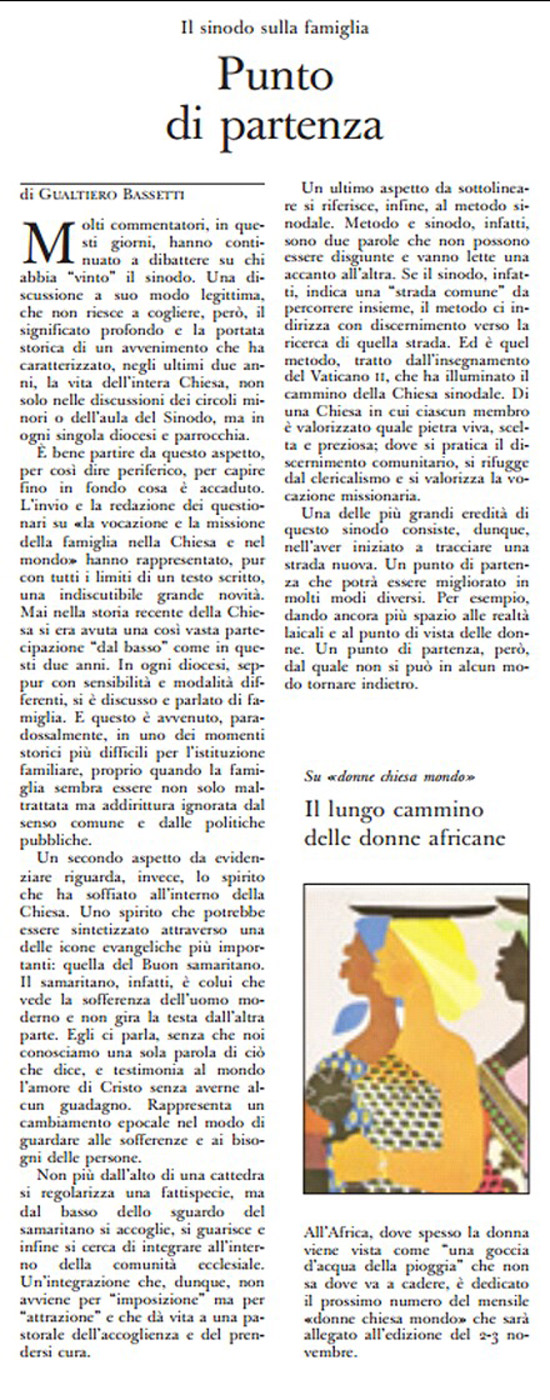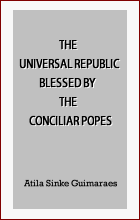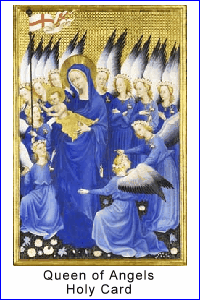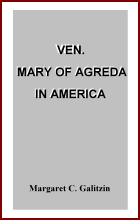What People Are Commenting
A Dying Europe & Vatican Backs up TIA
Dying Europe
TIA,
I am sending you a video that shows three things:
Please, watch the video here.
H.L.
I am sending you a video that shows three things:
- France is being invaded by Muslims, who have the support of the government and the indulgence of the police;
- Since people's safety is no longer guaranteed by the forces of order, white militias are being organized to protect themselves;
- The country seems to be heading toward a civil war.
Please, watch the video here.
H.L.
______________________
Rock and Roll
Dear TIA,
Re: Your series on Rock (here, here, here and here)
Not that one needs anymore nightmare Vatican II info. "After Altar dogs, what do you say???"
But these photos do have entertainment value, which is the goal of Vatican II. It's an entertainment. Show 'biz.
Attached is Rock and Roll Hall of Fame site (photo below).
The Rock and Roll Hall of Fame: Cleveland, Ohio. It is not an Aztec Temple; it just looks like one.
I'm sure the architectural "X" and the "W" are cryptic symbols for something but not sure what. Masonic symbols? There are two "w"s there. Cleveland Browns stadium to the left
Thank you,
E.K.

Re: Your series on Rock (here, here, here and here)
Not that one needs anymore nightmare Vatican II info. "After Altar dogs, what do you say???"
But these photos do have entertainment value, which is the goal of Vatican II. It's an entertainment. Show 'biz.
Attached is Rock and Roll Hall of Fame site (photo below).
The Rock and Roll Hall of Fame: Cleveland, Ohio. It is not an Aztec Temple; it just looks like one.
I'm sure the architectural "X" and the "W" are cryptic symbols for something but not sure what. Masonic symbols? There are two "w"s there. Cleveland Browns stadium to the left
Thank you,
E.K.

______________________
Hitting the Nail on the Head
Dear TIA,
This is an excellent analysis of the Synod. I believe the author of this article, Atila Guimaraes, hit the nail right on the head.
This should send shock waves to all concerned, even the three proverbial monkeys.
R.H.
This is an excellent analysis of the Synod. I believe the author of this article, Atila Guimaraes, hit the nail right on the head.
This should send shock waves to all concerned, even the three proverbial monkeys.
R.H.
______________________
L’Osservatore Romano Confirms TIA’s Input
Hello TIA,
A friend of mine sent me the article below on the Synod. It is in Italian from L’Osservatore Romano, which is the Vatican daily newspaper. The article was published on November 1, 2015, two days after TIA posted Guimaraes’ column on the Synod. It was published in the top right of the front page, implying that it is the Vatican's official interpretation on this topic.
The article confirms Guimaraes’ input on the Synod as being the starting point for the democratization of the Church. It also puts down those who are discussing who "won" at the Synod.
I thought you would like to know and let your readers know about this.
Since I don’t realize to what degree this interests you, I am saving my time and not translating it to English. I leave this task for you, if you think it useful.
Keep up the good work.
K.R

TIA’s translation
L'Osservatore Romano - November 1, 2015 - Front page
The Synod on the Family
The Starting Point
Gualtiero Bassetti
Many commentators today continue to debate about who "won" the Synod. It is a discussion in some way legitimate, but one that does not catch the profound significance and the historic dimension of an event that has characterized, in the last two years, the whole life of the Church, not only in the discussions of small groups of the Synod or in its general assembly, but also in every single diocese and parish.
It is good to depart from this peripheral aspect, so to speak, to understand more profoundly what has happened. The questions and answers [sent to and received from all Catholics around the world] about the "vocation and mission of the family in the Church and the world" indisputably represented a great novelty, although within the limits of a written text.
Never in the recent history of the Church has there been such a vast participation "from below" as there has been these last two years. In each diocese, even with their different sensibilities and ways of expressing themselves, the family was discussed and talked about. And, paradoxically, this took place in one of the most difficult historical moments for the familiar institution, when the family seems to be not only badly-treated, but even ignored by common sense and public policies.
A second aspect to comment on regards, conversely, the spirit that is now blowing inside the Church. A spirit that could be expressed by one of the more important icons of the Gospel: that of the Good Samaritan. The Samaritan, indeed, is the one who sees the suffering of the modern man and does not turn his head aside. He speaks to us even when we do not understand a word of what he says, and he testifies to the world Christ's love without expecting any reward. The way of looking at the suffering and needs of people represents an epochal change.
It is no longer from the height of a cathedra that one deals with the cases, but it is from below, with the eyes of the Samaritan that one welcomes, heals and tries to integrate the other into the ecclesial community. An integration that, therefore, does not occur by "imposition" but by "attraction" and gives life to a welcoming and caring pastoral.
A final aspect to underscore regards the synodal method. As a matter of fact, method and synod are two words that cannot be dissociated, but are read together. If the Synod, in effect, indicates a "common road" to walk together, the method leads us with discernment toward the quest of that road. And it is that method that, taken from the teaching of Vatican II, has enlightened the path of the Synodal Church. A Church where each member is valued as a living, chosen and precious stone; where a communitarian discernment is practiced; clericalism is avoided and the missionary vocation is valorized.
One of the greatest legacies of this Synod consists, therefore, in having begun to sketch a new road. It is a starting point that can be better in many different ways. For example: by giving still more space to the lay reality and to the viewpoint of women. It is a starting point, moreover, from which it is not possible to turn back. (emphasis added)
A friend of mine sent me the article below on the Synod. It is in Italian from L’Osservatore Romano, which is the Vatican daily newspaper. The article was published on November 1, 2015, two days after TIA posted Guimaraes’ column on the Synod. It was published in the top right of the front page, implying that it is the Vatican's official interpretation on this topic.
The article confirms Guimaraes’ input on the Synod as being the starting point for the democratization of the Church. It also puts down those who are discussing who "won" at the Synod.
I thought you would like to know and let your readers know about this.
Since I don’t realize to what degree this interests you, I am saving my time and not translating it to English. I leave this task for you, if you think it useful.
Keep up the good work.
K.R

______________________
TIA’s translation
L'Osservatore Romano - November 1, 2015 - Front page
The Starting Point
Gualtiero Bassetti
Many commentators today continue to debate about who "won" the Synod. It is a discussion in some way legitimate, but one that does not catch the profound significance and the historic dimension of an event that has characterized, in the last two years, the whole life of the Church, not only in the discussions of small groups of the Synod or in its general assembly, but also in every single diocese and parish.
It is good to depart from this peripheral aspect, so to speak, to understand more profoundly what has happened. The questions and answers [sent to and received from all Catholics around the world] about the "vocation and mission of the family in the Church and the world" indisputably represented a great novelty, although within the limits of a written text.
Never in the recent history of the Church has there been such a vast participation "from below" as there has been these last two years. In each diocese, even with their different sensibilities and ways of expressing themselves, the family was discussed and talked about. And, paradoxically, this took place in one of the most difficult historical moments for the familiar institution, when the family seems to be not only badly-treated, but even ignored by common sense and public policies.
A second aspect to comment on regards, conversely, the spirit that is now blowing inside the Church. A spirit that could be expressed by one of the more important icons of the Gospel: that of the Good Samaritan. The Samaritan, indeed, is the one who sees the suffering of the modern man and does not turn his head aside. He speaks to us even when we do not understand a word of what he says, and he testifies to the world Christ's love without expecting any reward. The way of looking at the suffering and needs of people represents an epochal change.
It is no longer from the height of a cathedra that one deals with the cases, but it is from below, with the eyes of the Samaritan that one welcomes, heals and tries to integrate the other into the ecclesial community. An integration that, therefore, does not occur by "imposition" but by "attraction" and gives life to a welcoming and caring pastoral.
A final aspect to underscore regards the synodal method. As a matter of fact, method and synod are two words that cannot be dissociated, but are read together. If the Synod, in effect, indicates a "common road" to walk together, the method leads us with discernment toward the quest of that road. And it is that method that, taken from the teaching of Vatican II, has enlightened the path of the Synodal Church. A Church where each member is valued as a living, chosen and precious stone; where a communitarian discernment is practiced; clericalism is avoided and the missionary vocation is valorized.
One of the greatest legacies of this Synod consists, therefore, in having begun to sketch a new road. It is a starting point that can be better in many different ways. For example: by giving still more space to the lay reality and to the viewpoint of women. It is a starting point, moreover, from which it is not possible to turn back. (emphasis added)

Posted November 3, 2015















Noticing your recent hate mail from those who know the mechanics of writing, please permit me to repeat what St. Augustine once said about the Latinists and Orators of ancient Rome: When one teaches fools the arts and skills of writing in hopes of cultivating writers or the rules of eloquence for speaking; he forms neither excellent writers nor orators. He does, though, place armaments in the hands of lunatics.
Considering St. Augustine combated the five major heresies of his time, Manichaeism, Arianism, Pelagianism , Donatism and Docetism, he certainly knew what it was to be hated, saying: There is no crown without a contest and no contest without enemies.
St. Augustine, pray for us.
S.M.